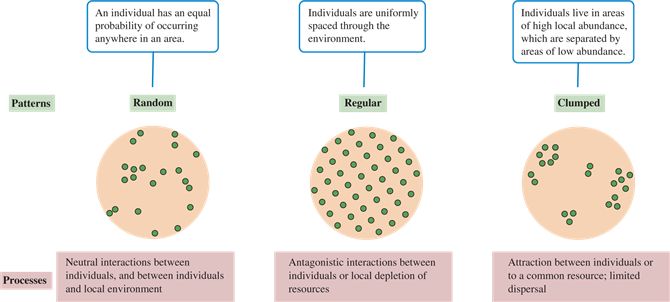 |
| Previous Image | Next Image |
| Description: Three basic patterns of distribution are observed on small scales: random, regular, or clumped. A random distribution is one in which individuals within a population have an equal chance of living anywhere within an area. A regular distribution is one in which individuals are uniformly spaced. In a clumped distribution, individuals have a much higher probability of being found in some areas than in others. These three basic patterns of distribution are produced by the kinds of interactions that take place between individuals within a population, by the structure of the physical environment, and by a combination of interactions and environmental structure. Individuals within a population may attract each other, repel each other, or ignore each other. Mutual attraction creates clumped, or aggregated, patterns of distribution. Clumped distributions can also occur if individuals produce offspring that fail to disperse far from the parents. Regular patterns of distribution are produced when individuals avoid each other or claim exclusive use of a patch of landscape. Neutral responses contribute to random distributions. The patterns created by social interactions may be re-inforced or reduced by the structure of the environment. An environment with patchy distributions of nutrients, nesting sites, water, and so forth also fosters clumped distribution patterns. An environment with a uniform distribution of resources and frequent, random patterns of disturbance (or mixing) tends to reinforce random or regular distributions. Let's now consider factors that influence the distributions of some species in nature.
Picture Stats: Views: 12933 Filesize: 29.83kB Height: 302 Width: 670 Source: https://biology-forums.com/index.php?action=gallery;sa=view;id=1817 |
